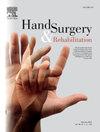掌侧锁定钢板近端孔背侧螺钉插入的安全性。
IF 1
4区 医学
Q4 ORTHOPEDICS
引用次数: 0
摘要
肌腱相关并发症是桡骨远端掌侧锁定钢板治疗后并发症的重要组成部分。虽然关于硬钉对桡骨远端掌侧和背侧骺后区影响的了解很多,但关于硬钉对骨干后区背侧影响的了解较少。本解剖研究的目的是评估背侧螺钉插入掌侧锁定钢板近端孔的安全性。我们将7孔掌侧锁定钢板应用于10具尸体前臂的桡骨远端。螺钉故意突出背部。从每个突出的背螺钉尖端测量到拇长外展肌、拇短伸肌、拇长伸肌和指共伸肌最近的点,注意最近的点是在肌腱上还是在肌腹上。结果表明,螺钉背突对拇长外展肌腹和拇短伸肌是最危险的结构,从远端到近端沿钢板移动时,从拇短伸肌平滑过渡到拇长外展肌是危险的焦点。第3孔的拇短伸肌风险最大,第6孔的拇长外展肌风险最大。所有突出螺钉与拇长外展肌或拇短伸肌直接接触的病例都是与腹部肌肉接触,而不是肌腱。桡骨远端平均前后位厚度从最近端螺钉孔13.9 mm到最近端螺钉孔11.5 mm不等。我们还发现拇长伸肌腱有与突出螺钉接触的危险,但仅在最远端近端螺钉孔处。总的来说,在掌侧锁定钢板近端孔插入背侧螺钉似乎是安全的,特别是当患者沿钢板近端移动时。本文章由计算机程序翻译,如有差异,请以英文原文为准。
Safety of dorsal screw penetration at the proximal holes of volar locking plates
Tendon-related complications comprise a significant portion of overall complications following volar locked plating of distal radius fractures. While much is known about the effect of prominent hardware in the volar and dorsal metaepiphyseal region of the distal radius, less is known about the effect of hardware prominence in the dorsal meta-diaphyseal region. The purpose of this anatomic study was to evaluate the safety of dorsal screw penetration at the proximal holes of volar locking plates. We applied a 7-hole volar locking plate to the distal radius of 10 cadaver forearms. Screws were intentionally protruding on the dorsal side. Measurements were taken from each protruding dorsal screw-tip to the nearest point on the abductor pollicis longus, extensor pollicis brevis, extensor pollicis longus and extensor digitorum communis, noting whether the nearest point was on the tendon or muscle belly. Results indicated that the muscle bellies of the abductor pollicis longus and extensor pollicis brevis were the structures most at risk from dorsal screw prominence, and that there was a smooth transition from the extensor pollicis brevis to abductor pollicis longus being the focus of risk as one moves from distal to proximal along the plate. The extensor pollicis brevis was most at risk at hole 3, and the abductor pollicis longus was most at risk at hole 6. All cases of direct contact between a protruding screw and the abductor pollicis longus or extensor pollicis brevis consisted of contact with the muscle belly, not the tendon. Average anteroposterior distal radius thickness ranged from 13.9 mm at the most distal proximal screw hole to 11.5 mm at the most proximal screw hole. We also found that the extensor pollicis longus tendon was at risk of contact with a protruding screw, but only at the most distal proximal screw hole. Overall, dorsal screw penetration at the proximal holes of volar locking plates appeared to be safe, particularly as one moves proximally along the plate.
求助全文
通过发布文献求助,成功后即可免费获取论文全文。
去求助
来源期刊

Hand Surgery & Rehabilitation
Medicine-Surgery
CiteScore
1.70
自引率
27.30%
发文量
0
审稿时长
49 days
期刊介绍:
As the official publication of the French, Belgian and Swiss Societies for Surgery of the Hand, as well as of the French Society of Rehabilitation of the Hand & Upper Limb, ''Hand Surgery and Rehabilitation'' - formerly named "Chirurgie de la Main" - publishes original articles, literature reviews, technical notes, and clinical cases. It is indexed in the main international databases (including Medline). Initially a platform for French-speaking hand surgeons, the journal will now publish its articles in English to disseminate its author''s scientific findings more widely. The journal also includes a biannual supplement in French, the monograph of the French Society for Surgery of the Hand, where comprehensive reviews in the fields of hand, peripheral nerve and upper limb surgery are presented.
Organe officiel de la Société française de chirurgie de la main, de la Société française de Rééducation de la main (SFRM-GEMMSOR), de la Société suisse de chirurgie de la main et du Belgian Hand Group, indexée dans les grandes bases de données internationales (Medline, Embase, Pascal, Scopus), Hand Surgery and Rehabilitation - anciennement titrée Chirurgie de la main - publie des articles originaux, des revues de la littérature, des notes techniques, des cas clinique. Initialement plateforme d''expression francophone de la spécialité, la revue s''oriente désormais vers l''anglais pour devenir une référence scientifique et de formation de la spécialité en France et en Europe. Avec 6 publications en anglais par an, la revue comprend également un supplément biannuel, la monographie du GEM, où sont présentées en français, des mises au point complètes dans les domaines de la chirurgie de la main, des nerfs périphériques et du membre supérieur.
 求助内容:
求助内容: 应助结果提醒方式:
应助结果提醒方式:


